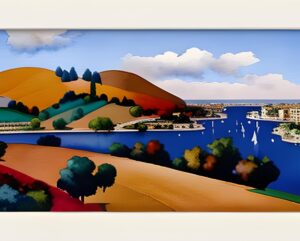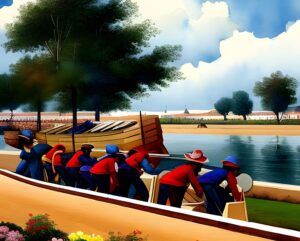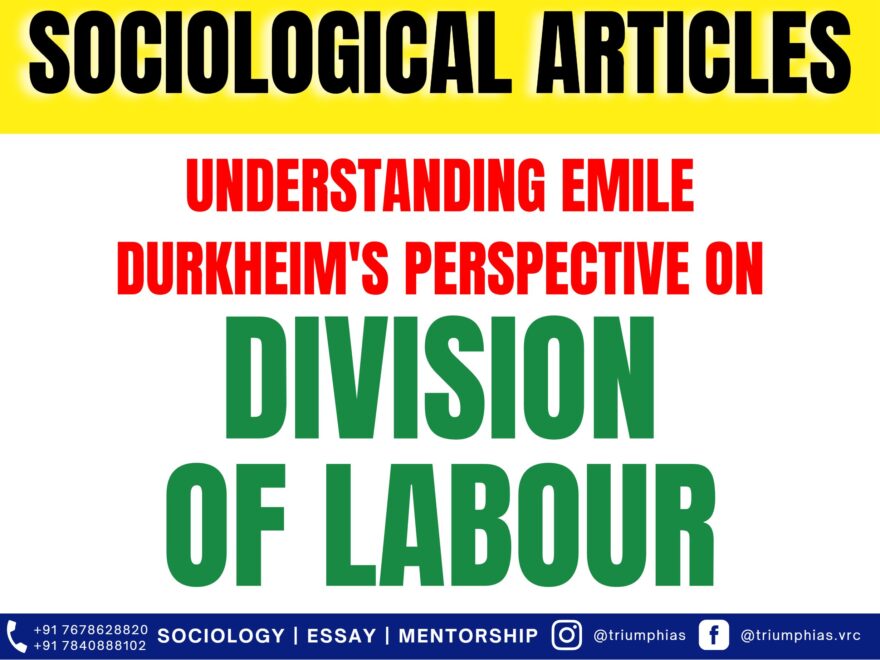Emile Durkheim – Division of labour
(Relevant for Sociology Optional Paper 1 (Unit 4))

Durkheim challenges the conventional explanation put forth by economists regarding the division of labor as a rational mechanism designed by individuals to enhance collective output. He argues that this perspective misrepresents the true sequence of events. According to Durkheim, to claim that individuals themselves divided the labor and allocated distinct roles assumes that people were inherently different from one another and aware of these differences prior to social differentiation.
Furthermore, Durkheim rejects the ideas proposed by “contractualists” like Spencer, who emphasized the growing significance of freely established contracts among individuals in modern societies. In Durkheim’s view, modern society is primarily defined by the phenomenon of social differentiation, with contractualism being the outcome and manifestation of this process. He also dismisses the notion that the pursuit of happiness serves as an explanation for the division of labor, as there is no evidence to suggest that individuals in modern societies are happier than those in archaic societies. Moreover, given that the division of labor is a social phenomenon, Durkheim asserts that a thorough understanding necessitates an explanation rooted in social factors, in accordance with the principle of the homogeneity of causes and effects.
Durkheim emphatically asserts that the division of labor, being inherently a social phenomenon, can only be comprehensively explained by considering three crucial social factors: volume, material density, and moral density.
- Volume pertains to t
 he size of the population, while material density refers to the concentration of individuals within a given geographical area. Moral density, on the other hand, signifies the intensity of communication and interaction among individuals. As cities form, communication and
he size of the population, while material density refers to the concentration of individuals within a given geographical area. Moral density, on the other hand, signifies the intensity of communication and interaction among individuals. As cities form, communication and - transportation systems develop, and society becomes more condensed, the number of interpersonal relations within the social fabric multiplies. Consequently, the growth and densification of societies necessitate a greater division of labor. Durkheim affirms, “The division of labor varies directly with the volume and density of societies, and its continuous progression throughout social development is a direct result of societies consistently becoming denser and larger.”
- As societies expand in both volume and density, individuals come into contact with a larger number of fellow members. This heightened interaction leads to competition for limited resources and rivalry becoming pervasive. In this context, as the struggle for survival intensifies, social differentiation emerges as a peaceful resolution to this predicament.
- With the adoption of diverse occupations by individuals, the likelihood of conflict diminishes. Each person is no longer engaged in competition with the entire society but rather with only a select few who share the same pursuit or vocation. A soldier seeks military glory, a priest aims for moral authority, a statesman pursues power, a businessperson seeks riches, and a scholar strives for scientific renown. The carpenter does not compete with the mason, nor does the physician contend with the teacher, and the politician does not vie against the engineer. Since individuals are engaged in different objectives or services, they can coexist without the need to mutually annihilate one another. Thus, the division of labor emerges as a direct outcome of the struggle for survival.
Durkheim identified two forms of solidarity– mechanical solidarity and organic solidarity in two types of societies- societies with simple division of labour & societies with complex division of labour:

Mechanical solidarity
- Mechanical solidarity can be understood as a form of solidarity based on resemblance. In societies characterized by mechanical solidarity, people are mentally and morally homogeneous. They share the same emotions, uphold identical values, and hold common beliefs as sacred. Consequently, communities exhibit a uniform and non-fragmented nature. Durkheim argued that mechanical solidarity thrives when “ideas and tendencies that are common to all members of society outweigh those that pertain to each individual.” He further explained that this type of solidarity grows inversely proportionate to individual personality.
- According to Durkheim, solidarity arising from likeness reaches its peak when the collective conscience completely envelops and aligns with the individual conscience in all aspects. Thus, a society marked by mechanical solidarity is characterized by a strong collective conscience. In such a society, crime is considered an offense against the “common conscience,” resulting in the presence of “repressive law” that emphasizes punishment to underscore the strength of shared sentiments.
- The laws in societies with mechanical solidarity are punitive and repressive in nature. They aim to inflict suffering or loss upon the criminal and seek to prevent the recurrence of criminal acts. Durkheim posited that an act is deemed criminal when it transgresses the strong and well-defined states of the collective conscience. Crime is perceived as a violation of the collective conscience, which experiences hurt as a result and endeavors to resist such behavior. Hence, one of the essential functions of punishments is to elicit actions and reactions at the collective level. In Durkheim’s words, “We must not say that an action shocks the common conscience because it is criminal, but rather that it is criminal because it shocks the common conscience. We do not reprove it because it is a crime, but it is a crime because we reprove it.”

Organic solidarity:
- As the volume of the population increases, so does the material density and moral density. Durkheim contends that the division of labor serves as a peaceful resolution to the challenges brought about by the growth in population size and density. This expansion of division of labor gives birth to organic solidarity, characterized by a decline in the collective conscience. The role of the collective conscience gradually diminishes as the division of labor becomes more specialized. Individuals experience increasing freedom while becoming more cognizant of their interdependence. It is this heightened awareness of interdependence that fosters solidarity. The freedom of the individual becomes a revered principle in a society founded on organic solidarity, where relationships between individuals and groups take on contractual nature.
- In contrast to mechanical solidarity, which stems from similarities among individuals in primitive societies, organic solidarity arises from differences rather than similarities in modern societies. Individuals are no longer alike but diverse, as their mental and moral similarities fade away. A society characterized by organic solidarity is distinguished by specialization, a complex division of labor, and individualism. It is sustained by the interdependence of its parts rather than the homogeneity of its constituents. This type of solidarity is also marked by the weakening of the collective conscience and the prevalence of restitutive law. Durkheim envisions organic solidarity as evolving from differences rather than similarities, emerging as a consequence of the division of labor. As a society’s functions become more differentiated, differences between its members arise.
- The emergence of division of labor in society, triggered by various factors such as increased population, urbanization, and industrialization, leads to an inevitable rise in interdependence among society members. As mentioned earlier, when there is an increase in mental and moral aptitude and capabilities, there is a corresponding decrease in the collective conscience. These two forms of solidarity correspond to two extreme forms of social organization. Archaic societies, previously referred to as primitive societies, are characterized by the dominance of mechanical solidarity, whereas modern industrial societies, characterized by a complex division of labor, are predominantly influenced by organic solidarity. It is important to note, however, that Durkheim’s understanding of the division of labor differs from that envisioned by economists. According to Durkheim, social differentiation begins with the disintegration of mechanical solidarity and segmental structure. Occupational specialization and the proliferation of industrial activities are merely expressions of a broader form of social differentiation that corresponds to the structure of society as a whole.
- In organic solidarity, the prevailing law is no longer punitive but restitutive. Unlike repressive law, which seeks to inflict suffering upon the criminal, restitutive law aims to restore the status quo. Additionally, while repressive law is diffuse throughout the community, restitutive law operates through specific organs and institutions such as tribunals, councils, and functionaries.
- The operation of restitutive law entails applying general rules to particular cases, which are derived from the needs and practices of society. Even when restitutive sanctions may not heavily rely on the collective conscience, it is still present. The power of contracts to bind individuals stems from the collective conscience. Moreover, this power can only be invoked when contracts align with the general rules of law and possess a moral dimension.
- When comparing organic solidarity to mechanical solidarity, Durkheim suggests that social cohesion is greater in the former. As labor becomes divided, each member of society becomes increasingly dependent on this labor. The work of one individual complements the work of another, resulting in a cohesive community. Consequently, as the community becomes more united and tightly integrated, individuals gain more freedom and are better able to exercise their initiative, as they are less constrained by shared sentiments.
- The division of labor thus contributes to both societal cohesion and individual self-expression and freedom. However, it is essential to note that the aforementioned discussion refers to the idealized form of organic solidarity

Abnormal forms of division of labour
Durkheim regarded the chaos 18th and 19th century laissez-faire society, its wholly unregulated markets, its arbitrary and extreme inequalities, which led to the restriction of social mobility and its class wars and trade union conflict, as far from normal division of labour. These aberrations of the industrial society were explained as abnormal forms of divisions of labour viz., the anomic division of labour and the forced division of labour.
- The concept of anomie, as applied to economic behavior, emphasizes that relationships between individuals or groups involved in commercial and industrial enterprises lack regulation based on shared moral beliefs. It acknowledges the existence of social classes and the recurring conflicts between them.
- Durkheim sees class conflict as a result of disputes and clashes arising from the absence of agreed-upon boundaries, driven by the insatiable appetites of manufacturers and entrepreneurs as well as the unlimited desires of workers. He views trade unions as a means to replace individual selfishness with collective selfishness, as competing representative groups strive to overcome the chaos within the economy.
- However, Durkheim does not view the conflict of interest between employers and employees as an insurmountable obstacle. He offers suggestions to alleviate the anomic state in modern industrial societies. He emphasizes the necessity of improving working conditions and contractual arrangements, such as implementing measures for employment provisions and safety legislation. The aim is to create a healthy work environment and replace the rule of power with the rule of law. Each industry should establish self-governing institutions or corporations that have the authority to enforce codes of conduct binding all those involved in the occupational realm.
- These institutions would maintain a connection with the state, as excessive decentralization of power can lead to anarchy. By doing so, the corporations can effectively safeguard their members against arbitrary state interventions. Durkheim also cites professional organizations like lawyers’ associations, which establish professional ethics to govern their work. He believes that such measures would significantly contribute to controlling the state of anomie prevalent in professional, industrial, and commercial life.
- According to Steve Fenton, Durkheim’s proposed solution for the anomic condition prevalent in industrial societies aligns with the concept of guild socialism.
Forced division of labour
- Within the category of the ‘Forced Division of Labour,’ Durkheim examines the societal inequalities that undermine solidarity. He explicitly acknowledges that class disparities limit the opportunities of the lower classes, impeding the realization of their potential. As a result, resentment accumulates, leading individuals to entertain revolutionary ideas. The problem lies not in a lack of rules but rather in their excessiveness, as the rules themselves become the source of evil. These rules have emerged to coercively enforce the division of labor. Specializations and occupations are not chosen freely by individuals but imposed upon them by custom, law, and even random chance. Consequently, individuals find themselves alienated, resentful, and yearning for social positions that have been unjustly denied to them.
- Durkheim notes that this situation is particularly evident when certain individuals enjoy special advantages due to inherited wealth or when social distinction is granted to individuals regardless of their merits, based on persistent prejudices. The forced division of labor thus creates what a contemporary author has termed “the anomie of injustice.” It is this state of affairs that has generated class conflict, rather than the inherently exploitative nature of capitalism as Marx would argue. Durkheim contends that while complete eradication of all forms of inequality may not be feasible, certain inequalities are “natural” and occur spontaneously, while others constitute “external inequality” that can be mitigated. Essentially, Durkheim advocates for the establishment of what is now known as “equality of opportunity” or a “meritocracy.” To achieve this, all forms of hereditary privilege must be abolished, as Durkheim writes, “There cannot be rich and poor at birth without there being unjust contracts.”
To master these intricacies and fare well in the Sociology Optional Syllabus, aspiring sociologists might benefit from guidance by the Best Sociology Optional Teacher and participation in the Best Sociology Optional Coaching. These avenues provide comprehensive assistance, ensuring a solid understanding of sociology’s diverse methodologies and techniques.
Emile Durkheim, Division of labour, Social differentiation, Mechanical solidarity, Organic solidarity, Abnormal forms of division of labour, Anomic division of labour, Forced division of labour, Sociology, Social theory, Best Sociology Optional Teacher, Best Sociology Optional Coaching, Sociology Optional Syllabus

